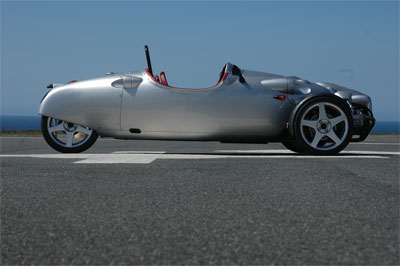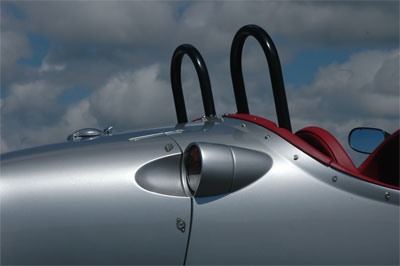|
|
In 2001 work began on a new trike at Blackjack Cars. At the time it wasn't known whether the new trike would replace the Citroen- engined Avion or whether it would run alongside. Having had six years with the Avion, the design, the driving, the building, the making of components, the sometimes close interaction with customers/builders and an accumulated knowledge of other makes of trike and their histories, the strengths and their failings, there emerged a strong collective desire for a trike with longer legs, more confident and predictable performance and handling. Perhaps a fast tourer capable of covering long distance with 'morish' driving characteristics and durability.
As with the Avion before it this new car would be front heavy and front wheel drive for maximum sure-footedness with a high degree of roll stiffness keeping it flat on the road with the rear wheel vertical at all times. 450kg dry weight, a proper reverse gear and sweet exhaust sound were targets. The right exhaust note would make distance travel more enjoyable and less tiring as would refined ride quality. No pitching or jarring. The car's interior would be spacious, comfortable and functional with a naturally protective feel and normally wasted space would be made accessible for luggage.
The Volkswagen Type 1 engine and gearbox was the chosen power train. It has a very good capacity to weight ratio with its super-light magnesium casings and potentially big cylinder bores. Placed at the front of the car in clean air it could run without its fan and airjacket making possible a unique Blackjack central induction arrangement and exhaust system. These engines have been made for forty five years, they are cherished and understood worldwide and on a huge scale have cult status. They are the basis of many performance and racing engines. This new fast tourer would require performance and economy, not the brutal power of the ten-lapper.
The body shape would be a lean aerodynamic tear-drop closely stretched around the essential internal space, a high scuttle for wind protection and just enough space for the rear wheel and its envelope of movement. The centre tub, tough with internal bracing and front and rear capped by light farings.
Connecting the mechanical components to the driving compartment would be a load-spreading frame from front to rear made from round tube with laser cut yokes at the front to carry the engine and gearbox and wishbones.
 |
|
 |
|
 |
|